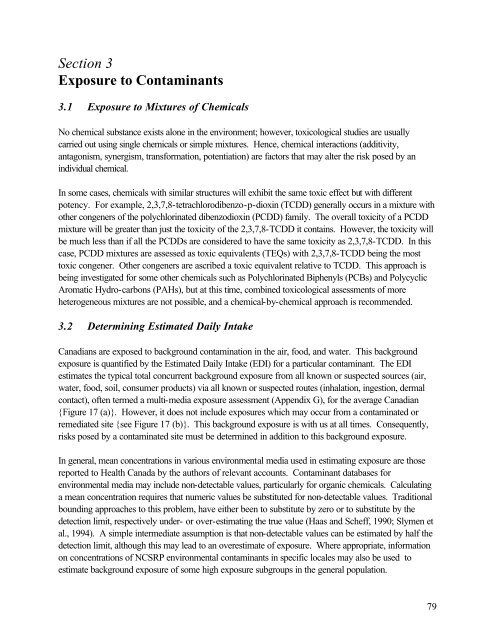Protocol for the Derivation of Environmental and Human ... - CCME
Protocol for the Derivation of Environmental and Human ... - CCME
Protocol for the Derivation of Environmental and Human ... - CCME
Create successful ePaper yourself
Turn your PDF publications into a flip-book with our unique Google optimized e-Paper software.
Section 3<br />
Exposure to Contaminants<br />
3.1 Exposure to Mixtures <strong>of</strong> Chemicals<br />
No chemical substance exists alone in <strong>the</strong> environment; however, toxicological studies are usually<br />
carried out using single chemicals or simple mixtures. Hence, chemical interactions (additivity,<br />
antagonism, synergism, trans<strong>for</strong>mation, potentiation) are factors that may alter <strong>the</strong> risk posed by an<br />
individual chemical.<br />
In some cases, chemicals with similar structures will exhibit <strong>the</strong> same toxic effect but with different<br />
potency. For example, 2,3,7,8-tetrachlorodibenzo-p-dioxin (TCDD) generally occurs in a mixture with<br />
o<strong>the</strong>r congeners <strong>of</strong> <strong>the</strong> polychlorinated dibenzodioxin (PCDD) family. The overall toxicity <strong>of</strong> a PCDD<br />
mixture will be greater than just <strong>the</strong> toxicity <strong>of</strong> <strong>the</strong> 2,3,7,8-TCDD it contains. However, <strong>the</strong> toxicity will<br />
be much less than if all <strong>the</strong> PCDDs are considered to have <strong>the</strong> same toxicity as 2,3,7,8-TCDD. In this<br />
case, PCDD mixtures are assessed as toxic equivalents (TEQs) with 2,3,7,8-TCDD being <strong>the</strong> most<br />
toxic congener. O<strong>the</strong>r congeners are ascribed a toxic equivalent relative to TCDD. This approach is<br />
being investigated <strong>for</strong> some o<strong>the</strong>r chemicals such as Polychlorinated Biphenyls (PCBs) <strong>and</strong> Polycyclic<br />
Aromatic Hydro-carbons (PAHs), but at this time, combined toxicological assessments <strong>of</strong> more<br />
heterogeneous mixtures are not possible, <strong>and</strong> a chemical-by-chemical approach is recommended.<br />
3.2 Determining Estimated Daily Intake<br />
Canadians are exposed to background contamination in <strong>the</strong> air, food, <strong>and</strong> water. This background<br />
exposure is quantified by <strong>the</strong> Estimated Daily Intake (EDI) <strong>for</strong> a particular contaminant. The EDI<br />
estimates <strong>the</strong> typical total concurrent background exposure from all known or suspected sources (air,<br />
water, food, soil, consumer products) via all known or suspected routes (inhalation, ingestion, dermal<br />
contact), <strong>of</strong>ten termed a multi-media exposure assessment (Appendix G), <strong>for</strong> <strong>the</strong> average Canadian<br />
{Figure 17 (a)}. However, it does not include exposures which may occur from a contaminated or<br />
remediated site {see Figure 17 (b)}. This background exposure is with us at all times. Consequently,<br />
risks posed by a contaminated site must be determined in addition to this background exposure.<br />
In general, mean concentrations in various environmental media used in estimating exposure are those<br />
reported to Health Canada by <strong>the</strong> authors <strong>of</strong> relevant accounts. Contaminant databases <strong>for</strong><br />
environmental media may include non-detectable values, particularly <strong>for</strong> organic chemicals. Calculating<br />
a mean concentration requires that numeric values be substituted <strong>for</strong> non-detectable values. Traditional<br />
bounding approaches to this problem, have ei<strong>the</strong>r been to substitute by zero or to substitute by <strong>the</strong><br />
detection limit, respectively under- or over-estimating <strong>the</strong> true value (Haas <strong>and</strong> Scheff, 1990; Slymen et<br />
al., 1994). A simple intermediate assumption is that non-detectable values can be estimated by half <strong>the</strong><br />
detection limit, although this may lead to an overestimate <strong>of</strong> exposure. Where appropriate, in<strong>for</strong>mation<br />
on concentrations <strong>of</strong> NCSRP environmental contaminants in specific locales may also be used to<br />
estimate background exposure <strong>of</strong> some high exposure subgroups in <strong>the</strong> general population.<br />
79
















